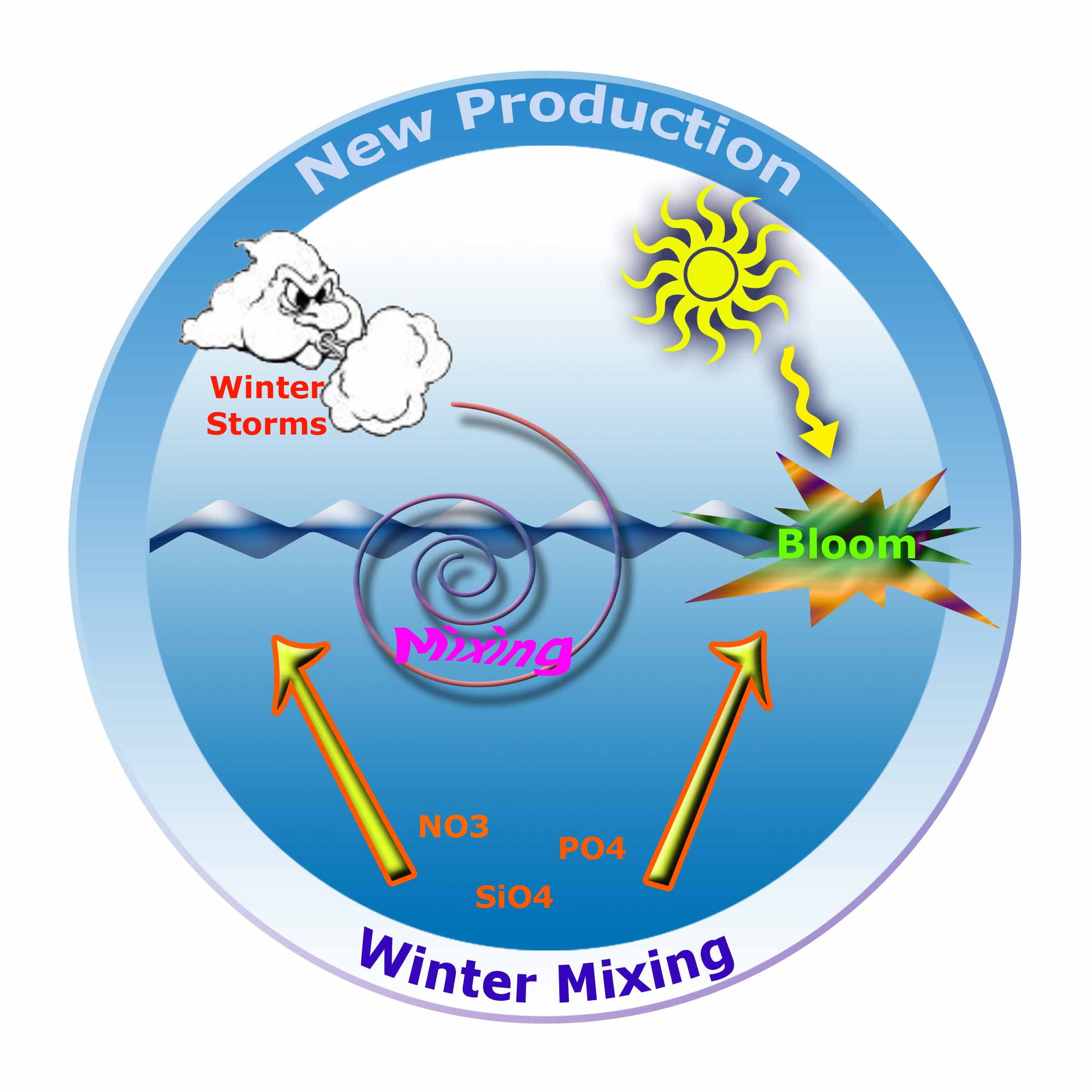Project: New Production During Winter Convective Mixing Events
Description
New Production During Winter Convective Mixing Events: A Missing Component of Current Estimates
Daily biogeochemical data collected during winter convection in the Sargasso Sea.
Photosynthetic uptake of CO2 by oceanic phytoplankton and the export of the resulting organic carbon to the deep sea comprise a 'biological pump' (Volk and Hoffert, 1985), capable of extracting globally significant amounts of CO2 from the atmosphere. As a consequence, it is important from the perspective of the global carbon cycle to understand both the present efficiency and the main controlling mechanisms of this important carbon pathway. In the open ocean the biological pump is driven by new production of organic matter (production supported by externally supplied nutrients) and export of that organic matter to depth. Many methods have been employed to estimate new production, with varying degrees of agreement.
In the Sargasso Sea, for example, geochemical estimates of new production largely exclude the winter mixing period (because their fundamental assumption are valid only during stratified periods). Biological methods suggest that the pre-stratification period can be as important, in terms of new production, as the remainder of the year. Those biological estimates are poorly constrained and based on sparse data. Because of the enormous spatial extent of subtropical gyres similar to the Sargasso Sea, uncertainty in the rate of new production and organic matter export in those systems leads to large uncertainty in biologically-driven carbon fluxes at the global-scale.
Short-term stochastic events are increasingly recognized as being disproportionately important for biogeochemical cycling and carbon storage in the ocean. Recent data suggest that in the Sargasso Sea, the passage of weather fronts leads to increased new production during the winter mixing period. We hypothesize that these events lead to enhanced NO3-input, followed by a rapid biological response and accumulation of biomass, and an equally rapid export of that biomass. This rapid export may be systematically missed by the 3-4 day particle trap deployments of the Bermuda Atlantic Time-series Study (BATS) because they are hypothesized to happen during or immediately after the passage of frontal systems, when the vessel used for the BATS sampling program does not leave port. Such events have, however, been captured as increases in the fluorometer traces at the Bermuda Testbed Mooring (BTM) and increases in organic carbon flux in the continuous Ocean Flux Program (OFP) sediment traps, both of which are deployed in the Sargasso Sea near Bermuda
We propose a process-oriented study of new production and its control during the period before formation of the seasonal thermocline in the BATS/BTM/OFP region near Bermuda. This study will be conducted during two 30-day cruises (one in 2004 and one in 2005) during the winter mixing period when the passage of these fronts is most common and when few data are available to constrain new production estimates. It will be crucial for this study to sample from a fully weather-capable research vessel, which can stay out and continue operations through most winter storms. We will use direct measurements of NO3-entrainment, NO3-uptake, phytoplankton community structure change, and dissolved and particulate organic matter export to elucidate the linkages between new production and export production as well as determine the main biological responses to short-term physical forcing. Particular emphasis will be placed on biogeochemically critical phytoplankton groups such as diatoms and coccolithophorids, which can exploit transiently favorable conditions of the kind we hypothesize to occur in late winter/early spring and which play a disproportionately large role in organic-matter export in many systems.
An understanding of ocean function is no longer important just to practicing ocean scientists. This project will provide information critical for biogeochemical modelers seeking to constrain future predictions of changes in the oceanic biological pump, and will also provide information of interest to students, teachers and the general public.
If in fact a significant, and previously unmeasured, amount of new production occurs in subtropical gyres during the winter mixing period, then biological processes in the central oceans play a greater role in the global carbon cycle - including regulation of atmospheric CO2 - than we recognize at present. Regardless of whether or not our study shows that this is the case, we will explain the results and their implications to graduate and undergraduate courses through the teaching programs at BBSR and OSU, to high-school and elementary-school teachers through a targeted teacher-training program at BBSR and to the broader public in seminars and other public presentations.
Related files
OC399-3 Cruise Report
OC408-1,2 Cruise Report
References:
Detailed information on phytoplankton analysis.
Lomas, M.W., Roberts, N., Lipschultz, F., Krause, J.W., Nelson, D.M., and Bates, N.R. 2009.
Biogeochemical responses to late-winter storms in the Sargasso Sea. IV. Rapid succession of
major phytoplankton groups.
Deep Sea Research I, 56: 892-909.
doi:10.1016/j.dsr.2009.03.004
Detailed information on all silica cycle measurements.
Krause, J.W., Nelson, D.M., and Lomas, M.W. 2009. Biogeochemical responses to late-winter
storms in the Sargasso Sea. 2009. II. Increased rates of biogenic silica production and export.
Deep Sea Research I, 56: 861-875.
doi:10.1016/j.dsr.2009.01.002
Maiti, K., Benitez-Nelson, C.R., Lomas, M.W., and Krause, J. W. 2009. Biogeochemical responses
to late-winter storms in the Sargasso Sea. IV. Comparison of Export Production by 234Th and
Sediment Traps.
Deep Sea Research I, 56: 875-892.
doi:10.1016/j.dsr.2009.01.008
Detailed information on general biogeochemical measurements.
Lomas, M.W., Lipschultz, F., Nelson, D.M., and Bates, N.R. 2009. Biogeochemical responses
to late-winter storms in the Sargasso Sea. I. Pulses of new and primary production.
Deep Sea Research I, 56: 843-861.
doi:10.1016/j.dsr.2008.09.002

People
Lead Principal Investigator: Michael W. Lomas
Bermuda Institute of Ocean Sciences (BIOS)
Co-Principal Investigator: Nicholas Bates
Bermuda Institute of Ocean Sciences (BIOS)
Co-Principal Investigator: Anthony Knap
Bermuda Institute of Ocean Sciences (BIOS)
Co-Principal Investigator: Fredric Lipschultz
National Aeronautics and Space Administration (NASA) HQ (NASA HQ)
Co-Principal Investigator: David M. Nelson
Institut Universitaire Européen de la Mer (IUEM)
Contact: Michael W. Lomas
Bermuda Institute of Ocean Sciences (BIOS)
